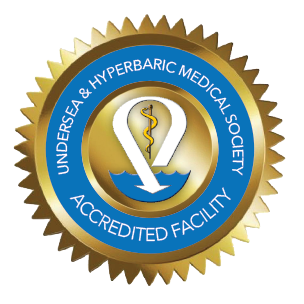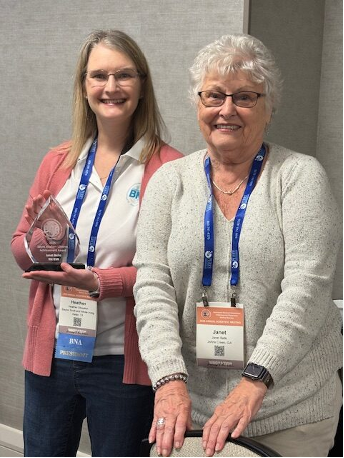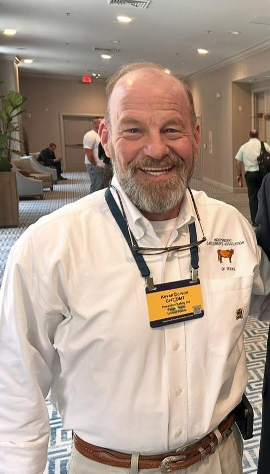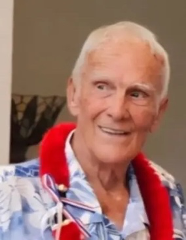Greetings from all of us here at the UHMS!
Time and tide wait for no man said Geoffrey Chaucer when he emphasized the need to seize opportunities before they pass by. At UHMS, we share that philosophy, and we are constantly scanning the horizon for opportunities that benefit our members through mission focus.
UHMS remains at the tip of the spear as every decision is anchored to our Vision and Mission. That focus delivers three compounding advantages. First, clarity over drift: The Vision/Mission serves as our filter—strategy, funding, partnerships, and public positions must all advance patient and staff safety, scientific rigor, education, and standards. Second, speed with integrity: clear north stars enable us to act quickly while safeguarding quality, whether responding to a threat to the UHM specialty or advancing the scientific knowledge of undersea and hyperbaric medicine. Third, credibility that truly compounds: consistent choices build trust with clinicians, hospitals, regulators, payers, and the public.
Mission alignment keeps UHMS forward-leaning by: prioritizing patient outcomes and clinical readiness (protocols and simulation); defending independent, rigorous accreditation and guidance; supporting high-quality research and registries; aiming education at competencies that reduce harm and publishing outcomes; leading policy with data on value, safety, and access; convening global partners across diving, hyperbaric, aerospace, military, and industry; modeling ethics and safety culture with transparent learning; and backing innovation where evidence, safety, and value are strongest.
Some of the initiatives underway this year include revising and strengthening the next edition of the UHMS Hyperbaric Medicine Guidelines (16th), revising the UHMS Hyperbaric Facility Accreditation Manual (5th), and significant IS and IT enhancements. UHMS is also working broadly with stakeholders to more effectively address and preempt crises. This effort will fall under the auspices of the new Hyperbaric Rulemaking Advisory Committee (HRAC). More to come on the HRAC later.
Annual Scientific Meeting Update (past and future)
Since the last Pressure newsletter, UHMS and AsMA successfully held the 2025 ASM in Atlanta, GA. The meeting was well-attended, with nearly 1,800 of our peers in attendance.
Please check out the 2025 Atlanta, GA, ASM photo gallery for some highlights of the meeting: https://tinyurl.com/drse63vt.
It was a serious production with eight concurrent sessions, ours being just one, and it worked, and next year, it’s going to be better, for all of our stakeholders.
Lisa Tidd and I had the opportunity to visit the site of the 2026 Joint Meeting in August, and I was impressed with the recently renovated property and the amenities inside and immediately surrounding the hotel. There were lots of dining and shopping options all within walking distance.

We’re pleased to share that our early bird rates for the upcoming meeting are consistent with those of last year. In a budget-conscious world, the savings are substantial compared to advanced or at-the-door registration.
We’re also excited to announce that we’ve secured annual scientific meeting locations and dates through 2034. With this schedule, we’ve negotiated 100% per diem hotel rates. This means a guaranteed lower cost for our attendees.
| Year |
Location |
Dates |
| 2026 |
Denver – Sheraton Downtown |
May 17-21 |
| 2027 |
Dallas – Hilton Anatole |
May 23-28 |
| 2028 |
New Orleans – Sheraton Canal St |
June 11-15 |
| 2029 |
Philadelphia – Marriott Downtown |
June 3-7 |
| 2030 |
Denver – Sheraton Downtown |
May 19-23 |
| 2031 |
Dallas – Marriott Downtown |
June 1-5 |
| 2032 |
New Orleans – Sheraton Canal St |
June 27-July 1 |
| 2033 |
Washington, DC – Marriott Marquis |
June 26-30 |
| 2034 |
San Francisco – Marriott Marquis |
June 25-29 |
The Importance of Certification
Certification is a hallmark of professional experience, competency, and commitment to best practices. Whether you are a physician, nurse, or technician, obtaining and maintaining your certification in hyperbaric medicine demonstrates your expertise and adherence to the highest standards of patient care. UHMS strongly encourages physicians in our field to pursue certification through ABPM/ABEM subspecialty board certification or PATH CAQ and NPPs to achieve PATH CAE; we also promote all nurses who participate in the care of hyperbaric patients to become Certified Hyperbaric Registered Nurses (CHRN) program, and technicians to be certified as Certified Hyperbaric Technologists (CHT) or Certified Hyperbaric Specialists (CHS). These credentials not only enhance your professional standing but also elevate the credibility of our specialty within the broader medical community.
Please review our position statement on Certification Matters: UHMS POSITION STATEMENT.
Facility Accreditation: A Commitment to Excellence
UHMS Hyperbaric Facility Accreditation remains the gold standard for ensuring safety, quality, and adherence to clinical best practices. Accredited facilities demonstrate their commitment to patient safety, operational excellence, and compliance with industry guidelines. If your facility is not yet accredited, I strongly encourage you to explore the process. Not only does accreditation improve patient trust and regulatory compliance, but it also serves as a proactive approach to risk management and liability reduction.
Maintaining Safety Diligence in Hyperbaric Systems
Safety is the foundation of everything we do in hyperbaric medicine. The risks associated with hyperbaric oxygen therapy (HBO2) demand unwavering diligence in maintaining equipment, conducting regular safety drills, and ensuring proper staff training. UHMS provides comprehensive guidelines and resources to help facilities uphold the highest safety standards, including routine inspections, emergency preparedness protocols, and compliance with NFPA 99 and ASME PVHO-1 standards. I urge all members to prioritize safety in their daily operations and take advantage of UHMS educational offerings on hyperbaric safety.
The Value of UHMS Membership
Your membership in UHMS is more than just an affiliation—it is an investment in your professional growth and the advancement of hyperbaric medicine. As a UHMS member, you gain access to cutting-edge research, clinical practice guidelines, educational opportunities, networking events, and advocacy efforts that aim to shape the future of our specialty. Additionally, membership provides exclusive discounts on conferences, workshops, and certification programs that support your career development.
The UHMS tent is wide open, so please come in and join us to make our specialty vibrant and viable for generations to come!
UHMS Finances
I am pleased to report that UHMS's financial position remains strong.
| Jan-Aug 2025 PL |
|
|
Actual |
|
Budget |
| Income |
|
$1,077,304 |
|
$1,028,138 |
| Expense |
|
$902,665 |
|
$860,942 |
| Net |
|
$174,639 |
|
$167,196 |
Our balance sheet remains healthy, with operating, savings, and investment accounts continuing to hover at near-all-time highs.
Member Benefits
As a reminder, UHMS members receive three free CE/CME credits upon joining or renewing. This benefit represents an immediate $40 savings for Associate members and $60 for Regular members annually.
Associate Member Town Hall
Members are invited to attend the UHMS Associate Council town hall meeting, held on the second Thursday of every quarter, where invited speakers present on relevant topics applicable to our specialty.
Corporate Partners
If you are a UHMS Corporate Partner, please attend our monthly Corporate Partner Town Hall meeting series. These meetings are held on the 1st Wednesday of every month at 12 PM and are intended to be an open forum for discussing the challenges and successes your businesses and practices are experiencing, as well as creating momentum and collaboration where appropriate.
If your organization wants to educate the UHMS membership about the care provided or the goods and services offered, consider joining our Corporate Partnership Program. See https://www.uhms.org/corporate-memberships.html.
MEDFAQs
The UHMS offers its version of "ask the experts." MEDFAQs can be found at the following URL – https://www.uhms.org/resources/medfaqs-frequently-asked-questions-faq.html, and is a valuable tool for our membership.
If you are familiar with MEDFAQs, check back, as new Q&As are posted regularly.
Research
The UHMS Research Committee remains highly active. UHMS is currently funding systematic analyses and provides funding to Dartmouth University for the Multicenter Registry for Hyperbaric Oxygen Therapy (MRHBO2). This is important because these contributions help keep the registry free for participating members. The MRHBO2 is funded entirely through grants, not by the participating hospitals of the registry - https://www.uhms.org/donate-to-the-multicenter-registry-for-hyperbaric-oxygen-therapy.html.
QUARC
To better understand the field's challenges, log in and visit the QUARC page – https://www.uhms.org/resources/quarc.html. Here, you will find impending legislation and other relevant policies on the provision and limitations of HBO2 coverage and the UHMS's responses and guidance.
The chairs of QUARC are requesting that any unusual denials or challenges with physicians gaining access to insurance panels for HBO2 services, let us know as soon as possible, please – jpeters@uhms.org.
UHMJ
If you are a UHMS member, we are happy to announce a new search feature for previous issues and articles from UHM/UBR - https://www.uhms.org/publications/uhm-journal/download-uhm-journal-pdfs.html. Currently, the feature works with keywords.
Looking Ahead
UHMS remains committed to expanding educational initiatives, strengthening industry partnerships, and advocating for policy advancements that benefit our field. We encourage you to engage with us, participate in upcoming events, and contribute to the ongoing dialogue that shapes hyperbaric and undersea medicine.
Thank you for being an integral part of our Community. Your expertise, dedication, and continued engagement make a difference in advancing the science and practice of undersea and hyperbaric medicine.
If you have a suggestion or comment on how we can better serve you, please email me at jpeters@uhms.org or call 561-776-6110 extension 100.
Sincerely,
John Peters
Executive Director
Undersea and Hyperbaric Medical Society
 April 2025
April 2025



 Kevan Corson, CHT, CHWS, DMT-I, a pioneer and patient advocate in the safety and advancement of hyperbaric oxygen (HBO2) therapy.
Kevan Corson, CHT, CHWS, DMT-I, a pioneer and patient advocate in the safety and advancement of hyperbaric oxygen (HBO2) therapy. James W. McCarthy
James W. McCarthy